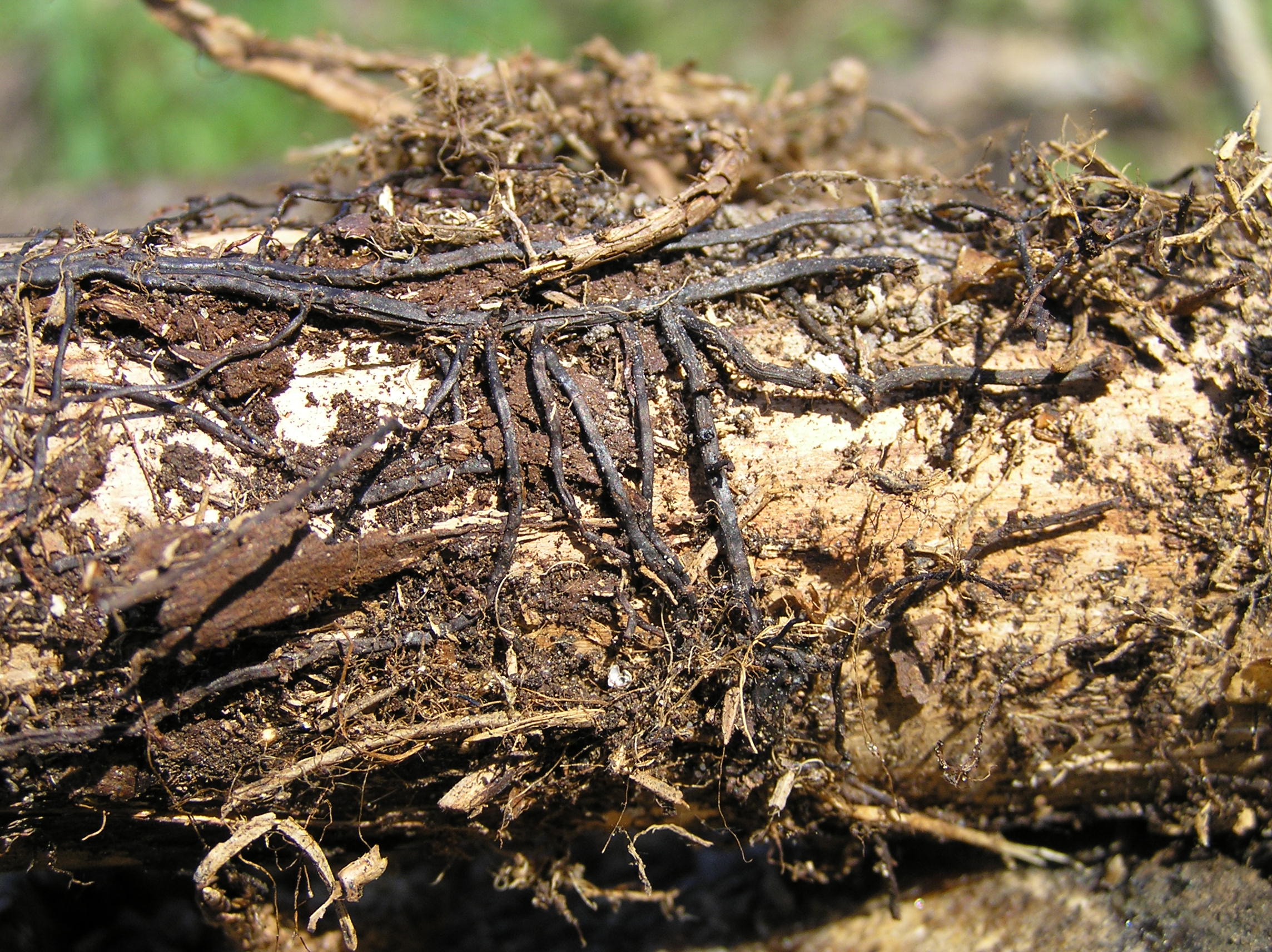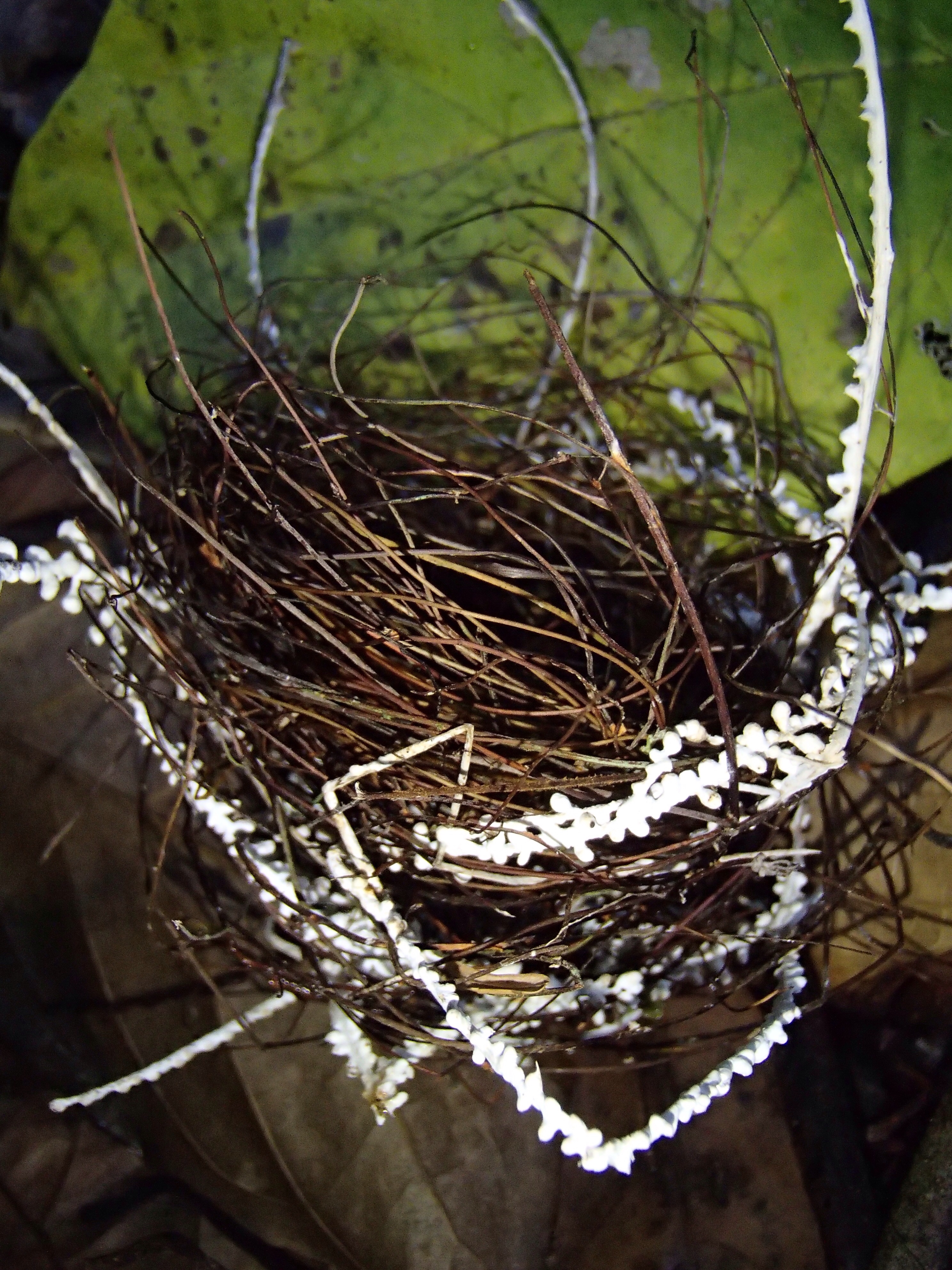Rhizomorpha on:
[Wikipedia]
[Google]
[Amazon]
''Rhizomorpha'' is a genus of fungi that was created for species known only by their
 The genus was created in 1791 by
The genus was created in 1791 by
 In 1799 James Sowerby published a mycelial cord species under the name ''Sphaeria hypotrichoides'', which was then renamed to ''Rhizomorpha hippotrichoides'' by
In 1799 James Sowerby published a mycelial cord species under the name ''Sphaeria hypotrichoides'', which was then renamed to ''Rhizomorpha hippotrichoides'' by  The name ''Rhizomorpha'' should now be avoided, but at the time of writing there is still at least one species which is found only in the form of mycelial cords and for which no spore-bearing structures have been observed. This species is ''
The name ''Rhizomorpha'' should now be avoided, but at the time of writing there is still at least one species which is found only in the form of mycelial cords and for which no spore-bearing structures have been observed. This species is ''
mycelial cords
Mycelial cords are linear aggregations of parallel-oriented hyphae. The mature cords are composed of wide, empty vessel hyphae surrounded by narrower sheathing hyphae. Cords may look similar to plant roots, and also frequently have similar function ...
("rhizomorphs") and so impossible to classify within the normal taxonomic system, which is based on reproductive structures.
Origin and naming
Mycelial cords
Mycelial cords are linear aggregations of parallel-oriented hyphae. The mature cords are composed of wide, empty vessel hyphae surrounded by narrower sheathing hyphae. Cords may look similar to plant roots, and also frequently have similar function ...
, or rhizomorphs, are long strands sent out by some fungi to colonize new space and absorb nutrients. They typically run along the ground or under bark, but may also hang in the air. They are complex structures, big enough to be seen with the naked eye, and they should not be confused with the microscopic thread-like cells (hyphae
A hypha (; ) is a long, branching, filamentous structure of a fungus, oomycete, or actinobacterium. In most fungi, hyphae are the main mode of vegetative growth, and are collectively called a mycelium.
Structure
A hypha consists of one or ...
) of which they are composed. Fungi are generally classified according to their sexual or asexual spore
In biology, a spore is a unit of sexual or asexual reproduction that may be adapted for dispersal and for survival, often for extended periods of time, in unfavourable conditions. Spores form part of the life cycles of many plants, algae, f ...
-bearing organs (including fruiting bodies where present), but where only sterile rhizomorphs were available, such species were put into genus ''Rhizomorpha'' even if they were not genetically related.
 The genus was created in 1791 by
The genus was created in 1791 by Albrecht Wilhelm Roth
Albrecht Wilhelm Roth (6 January 1757 – 16 October 1834) was a physician and botanist born in Dötlingen, Germany.
He studied medicine at the Universities of Halle and Erlangen, where he received his doctorate in 1778.
After graduation, he pra ...
for an observation of material in the form of mycelial cords, which he assigned to species ''Rhizomorpha fragilis''. Later the name ''Rhizomorpha'' was sanctioned (given guaranteed priority) by Elias Magnus Fries
Elias Magnus Fries (15 August 1794 – 8 February 1878) was a Swedish mycologist and botanist.
Career
Fries was born at Femsjö (Hylte Municipality), Småland, the son of the pastor there. He attended school in Växjö.
He acquired ...
.
But the cords of ''R. fragilis'' were subsequently determined actually to belong to the well-known mushroom taxon '' Armillaria mellea'' (Honey Fungus). The genus '' Armillaria'' was not defined until 1857 and therefore according to the precedence rules of botanical and mycological nomenclature, the name ''Armillaria'' is illegitimate and needs to be replaced everywhere by ''Rhizomorpha''. To avoid this inconvenience, in a 2021 paper covering numerous similar cases, Stalpers et al. have proposed that the name ''Armillaria'' should be protected. That decision remains to be taken by the Nomenclature Committee for Fungi and ultimately by an International Botanical Congress
International Botanical Congress (IBC) is an international meeting of botanists in all scientific fields, authorized by the International Association of Botanical and Mycological Societies (IABMS) and held every six years, with the location rotat ...
.
With DNA analysis it should nowadays always be possible to assign observed material to genera in the normal taxonomic tree, and those genera should be used instead of ''Rhizomorpha''. However it is still a legitimate genus name.
Example species
 In 1799 James Sowerby published a mycelial cord species under the name ''Sphaeria hypotrichoides'', which was then renamed to ''Rhizomorpha hippotrichoides'' by
In 1799 James Sowerby published a mycelial cord species under the name ''Sphaeria hypotrichoides'', which was then renamed to ''Rhizomorpha hippotrichoides'' by Fries
French fries (North American English), chips (British English), finger chips (Indian English), french-fried potatoes, or simply fries, are '' batonnet'' or ''allumette''-cut deep-fried potatoes of disputed origin from Belgium and France. The ...
in 1849 and later to ''Xylaria hippotrichoides'' by Pier Andrea Saccardo in 1882 when asci ASCI or Asci may refer to:
* Advertising Standards Council of India
* Asci, the plural of ascus, in fungal anatomy
* Accelerated Strategic Computing Initiative
* American Society for Clinical Investigation
* Argus Sour Crude Index
* Association of ...
and spores had been observed. This species has the English vernacular name "Horsehair Candlesnuff".
 The name ''Rhizomorpha'' should now be avoided, but at the time of writing there is still at least one species which is found only in the form of mycelial cords and for which no spore-bearing structures have been observed. This species is ''
The name ''Rhizomorpha'' should now be avoided, but at the time of writing there is still at least one species which is found only in the form of mycelial cords and for which no spore-bearing structures have been observed. This species is ''Brunneocorticium
''Brunneocorticium'' is a genus of fungi which following DNA analysis has been placed in the family Marasmiaceae. The genus, described in 2007, contains two corticioid species and one species (''B. corynecarpon'') which does not seem to have any ...
corynecarpon'', which was originally described by Gustav Kunze
Gustav Kunze (4 October 1793, Leipzig – 30 April 1851, Leipzig)
was a German professor of zoology, an entomologist and botanist with an interest mainly in ferns and orchids.
Kunze joined the Wernerian Natural History Society in Edinburgh in 181 ...
in 1828 as ''Rhizomorpha corynecarpos''. It consists of broad white aerial rhizomorphs which have frequent short branches and it occurs in the tropical forest canopy in Suriname and some other South American countries. It causes significant damage to trees and it is sometimes used by birds as nesting material. In 2018, molecular studies led it to be assigned to genus ''Brunneocorticium'' within the Marasmiaceae
The Marasmiaceae are a family of basidiomycete fungi which have white spores. They mostly have tough stems and the capability of shrivelling up during a dry period and later recovering. The widely consumed edible fungus ''Lentinula edodes'', the ...
, a family which consists mainly of mushroom-forming genera. Other members of the Marasmiaceae, such as '' Marasmius crinis-equi'' ("Horse Hair Fungus") also have aerial rhizomorphs.
Numerous other species names have been assigned under genus ''Rhizomorpha'', and the Mycobank database currently lists 96 such names.
References
{{Taxonbar, from=Q14905764 Enigmatic fungus taxa